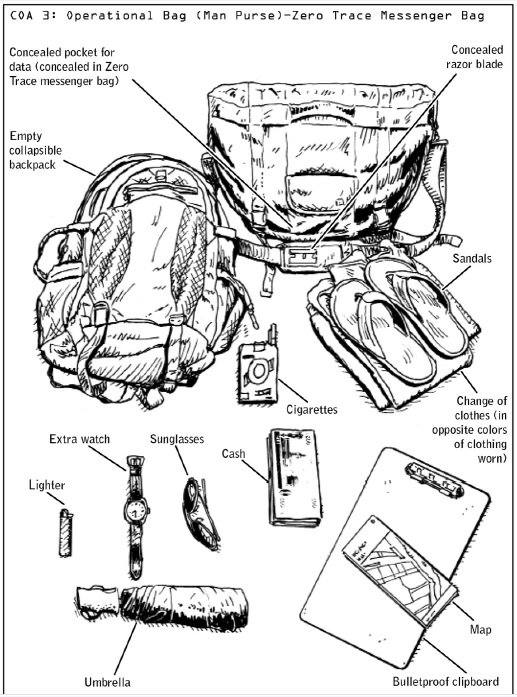Create an Every Day Carry Kit
While the average civilian approaches emergency preparedness from a life-support
perspective that prioritizes food and water supplies (stashed deep in a home basement) to
the exclusion of weapons and escape tools, true preparedness acknowledges and confronts
the violence of the modern world. To ensure a state of constant preparedness, the Violent
Nomad carries up to three types of Every Day Carry (EDC) kits, each designed to support
his mission and help him evade crisis. Whether the call comes or not, the EDC kits also
provide an edge against unexpected threats of all sorts, from environmental disasters to
terrorist strikes and lone-wolf attacks.
When traveling through potentially hostile territory or during turbulent times, a Nomad
will distribute several layers of life-support and personal-safety items throughout his
clothing and outerwear; in the event that he is stripped of his primary weapon, this
practice may leave him with several undetected options of last resort. Escape gear in
particular should be spread out in such a way that some of it remains available if the
Nomad is restrained.
The most basic kit, the “pocket kit,” should be comprised of essential weapons, escape
and evasion equipment, and one “black” (covert) mobile phone. Rather than being
consolidated into a single container or concealment, these items should be distributed
throughout clothing. A handgun should be concealed in a waistband holster, for the most
accessible draw. (See page 152 for tips on drawing a holstered weapon.) An emergency
communication device is essential, but other contents will vary depending on the terrain. A
stainless steel Zebra pen can be used to leave notes for potential rescuers—or to strike an
assailant. In the case of abduction or detention, a handcuff key and LED light camouflaged
alongside car or hotel keys are potential lifesavers; as backup in the event that clothes
pockets are searched, a concealable handcuff key can be hidden in a shirt cuff or on a
zipper pull. Some operatives carry mouthpieces, which can be vital during hand-to-hand
combat.
The “container kit”—generally tucked into a jacket or an operational bag (see below)—
functions as backup in the event that an operative is stripped of his primary weapon and/or
operational bag. This highly condensed kit contains small improvised weapons (loose coins
tied up in a handkerchief) and navigational aids (a headlamp and a handheld GPS device)
that change depending on the environment, as well as lock-picking tools that could provide
access to information, food, or shelter. Purchased within the area of operation, a set of
“recci” (reconnaissance) key blanks provides an advantage in breaking-and-entering
scenarios. Durable and reliably discreet, a rigid sunglass case is the optimal container for
this kit.
The final piece of the puzzle is the operational bag. To prepare for the possibility of
escape in the face of surveillance or attack, its contents should include an empty collapsible
backpack and a change of clothes in colors opposite from the ones the operative is
wearing. Even shoes should be taken into consideration—if wearing sneakers, pack a pair
of rubber sandals. A concealed pocket holds highly sensitive data on memory devices such
as thumb drives or SD cards, a Kevlar clipboard acts as an innocuous-looking form of
improvised ballistic armor, and a wad of cash allows the Nomad to subsist in deep cover
for as long as the situation demands.


Hey cool post :)
thanks! if you want more make me know! greatings!